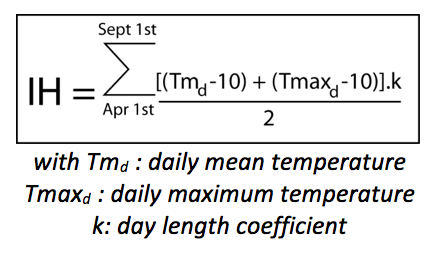The amount of sunshine: critical criteria for grapes ripening
There are a few important indices you want to look at closely when it comes to the ripening period for grapes and the Huglin index is definitely one of them. This index, unlike the Winkler index (Growing Degree Days), takes into account the duration of the day thanks to a coefficient named « day length » (Table 1). This coefficient brings into the formula the concept of the potential amount of light the plant receives, grapevine growth being strongly related to hours of sunshine. This corrects possible gaps from the simple formula of the growing degree days (Winkler index).
 Table 1. Examples of « day length » coefficients according to latitude positions (from Vaudour, 2003)
Table 1. Examples of « day length » coefficients according to latitude positions (from Vaudour, 2003)
How is the Huglin index calculated?
In the North Hemisphere the Huglin index is:

In the South Hemisphere, this index will be calculated over the period « October 1st - March 31st ». This index was created by Huglin in 1978 after several tests were applied on Winkler and Branas indices with the ampelographic collection of the agronomic station of the French agronomic institute in Colmar, France. In the end, the Huglin index, calculated over a 6 months’ period, was way more correlated with the sugar content of hundreds of varieties (Vaudour, 2003).

Table 2. Correlations between different bioclimatic indices and sugar content in grapes (adapted from Huglin, 1978)
Maximum temperatures, integrated in the Huglin formula, allow to differentiate vineyards with similar mean temperatures, but different viticultural potentials according to daily temperatures range. Tonietto proposed a classification of viticultural climates based on the Huglin index calculation applied to around thirty wine countries. As a result, he obtained 6 different classes characterizing viticultural regions from the coldest to the warmest. Table 3 shows these classes and some examples of viticultural regions. The examples of the viticultural regions in the table are the one observed over the 1961-1990 period when Huglin performed his study.
 Table 3. Huglin index classes (from Tonietto, 1999)
Table 3. Huglin index classes (from Tonietto, 1999)
While the Winkler index, is widely studied because correlations between this index and the different phenological stages are statistically significant, the Huglin index is interesting to follow between veraison and harvest in order to highlight ripening potentials of grapes. Wine-makers are used to do samples right before harvest to make sure grapes reach the right balance between sugar and acidity. Huglin index maps can help them to manage more efficiently their sampling and schedule grapes picking itinerary. Indeed, Huglin supplied comparisons between values of sugar content, and proposed different values depending on the grape variety. The data on which the statistical study was based are however limited in space, despite the large number of grapevine varieties. Nevertheless, Huglin proposed index values for different grape varieties, to allow a sugar content of 180 – 200 g/l (Table 4).

Table 4. Huglin index values allowing a sugar content of 180-200 g/l (according to Huglin experiment in 1978)
Congratulations @fruitionsciences! You received a personal award!
You can view your badges on your Steem Board and compare to others on the Steem Ranking
Vote for @Steemitboard as a witness to get one more award and increased upvotes!
Downvoting a post can decrease pending rewards and make it less visible. Common reasons:
Submit